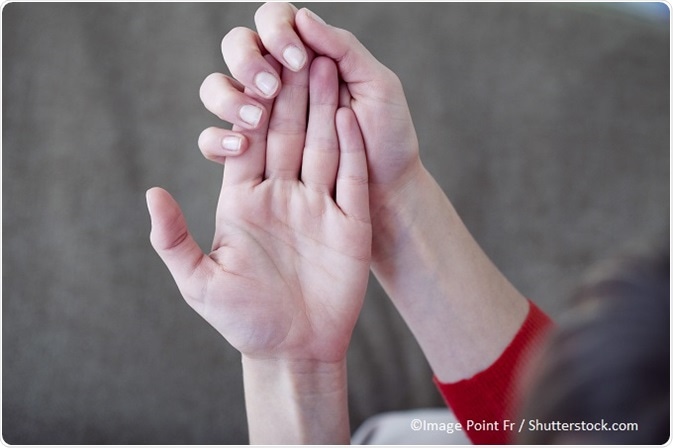Raynaud’s phenomenon is a relatively rare medical condition which causes a reduction of blood circulation to the fingers or toes when exposed to cold temperatures or during stressful situations. It is signaled by a change in color from the normal to a bluish-white, often accompanied by discomfort and pain. While this is a normal physiological reaction, it is exaggerated in this condition.

The duration of the change may last from a few seconds to hours. After a variable interval, blood circulation resumes, and the skin turns first red and then the healthy pink color. Along with this the individual may experience numbness followed by pins and needles or pain in the blanched region. The strange thing is that blood flow in every other part of the body is unaffected.
Its prevalence is higher in females, and especially under the age of 25 years. However, five in every hundred people have this condition overall. It may run in families, which points to an inherited pattern. Also, the prevalence is higher in regions with colder temperatures.
While the reduction in blood flow does not cause permanent damage, the phenomenon should be investigated to make sure that it does not indicate any serious associated illness (most commonly certain autoimmune disorders).
Types of Raynaud’s phenomenon
Raynaud’s phenomenon may be primary, which means it sets in without any other medical condition to cause it. Primary Raynaud’s phenomenon is also called Raynaud’s disease. It may be very mild, never requiring a medical consultation. It is likely to be due to some as yet unknown autonomic dysregulation of the blood vessels.
In the secondary type, it is found in relation to another disease, often an autoimmune one. Many individuals go on to develop conditions such as rheumatoid arthritis, scleroderma, and systemic lupus erythematosus. A few cases are caused by mechanical vibration such as prolonged daily use of vibrating tools, and are known as ‘industrial white finger’. It is presumed to be due to mechanical disruption of nerve impulses.
Other risk factors
Other associated conditions include:
- Atherosclerosis or plaque-induced narrowing of arteries, which may further reduce blood flow to the limb tips
- Smoking because of the vasoconstrictor effect of cigarette smoke
- Certain medications which cause vasoconstriction, including beta blockers, ergot derivatives, hormonal contraceptives or other female hormone-containing drugs, as well as some chemotherapeutic drugs
- The effects of freezing on the body, or frostbite
- Certain infections such as hepatitis B and hepatitis C
- Cancers of some types, especially of the hemopoietic or immune systems, may trigger the phenomenon, including acute lymphoblastic leukemia or lymphomas
- Drug abuse of some types, such as cocaine or amphetamine use, may set off the condition
- In some cases, a prior injury was noted; in others, overuse of the fingers (such as by professional musicians or typists) may be a risk factor
Diagnosis and management
The phenomenon is quite typical but it requires careful differentiation to distinguish the primary from the secondary form. A complete history, physical examination, and blood tests will point to the right diagnosis, while a fingernail biopsy may be warranted.
A useful test in this condition is the cold stimulation test which seeks to replicate the changes observed in Raynauds’s phenomenon by exposing the extremities to cold. Although the test itself may cause some mild discomfort, there are no adjacent risks.
When pins and needles are due to primary Raynaud’s phenomenon, warming the extremities is of help in relieving the symptoms if triggered by cold. This may be done by soaking them in warm water. Stress should be avoided as far as possible.
Secondary Raynaud’s phenomenon requires a different approach. The causative illness must be treated, and benefit usually follows such therapy. In refractory cases, vasodilators may be needed to prevent the tissue at the fingertips from undergoing ischemic damage. Ulceration may set in otherwise, and may lead to the need for surgical treatment.
Prevention
Patients who suffer from long-term pins and needles because of Raynaud’s phenomenon must take the following precautions:
- Avoid known triggering factors such as cold and abrupt changes in ambient temperature, or handling cold objects.
- Dress in layers to conserve body heat, including gloves and woolen socks
- Occupational therapy may help adjust to daily demands without triggering the vascular changes
- Avoid smoking and caffeine
- Review all medications with the healthcare provider and avoid or stop vasoconstrictors
- Be alert to the possibility of impending stress and adoption of appropriate relaxation and problem-solving strategies
- Keep track of each episode for a few months to spot any unrecognized triggers
- Regular exercise helps improve blood flow throughout the body, as well as energy levels and cardiovascular health
- Dietary care will help achieve lower blood lipid levels
References
- https://www.betterhealth.vic.gov.au/health/conditionsandtreatments/raynauds-phenomenon
- https://www.nhlbi.nih.gov/health/health-topics/topics/raynaud
- http://www.nhs.uk/Conditions/Raynauds-phenomenon/Pages/Causes.aspx
Further Reading
Last Updated: Feb 27, 2019